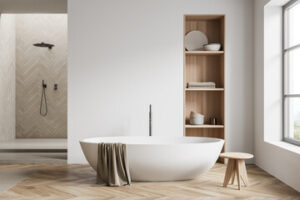Before you begin, you should make sure that you level the bathtub by using a leveling tool. Make sure that the flanges of the back section of the tub match those of the studs on the walls. Next, screw the tub to the wall with two-inch galvanized screws. While screwing the tub to the wall, place a foot on the edge of the tub to hold it in place. If necessary, place wood shims under the tub to keep it level.
Before you begin the Bathtub Installation process, make sure that your bathroom is properly framed. You will need to install solid between-the-stud framing if you want to add recessed nooks, shelves, and other bolt-on accessories. You will also need to install horizontal stringers across the studs. If possible, you should nail these pieces directly to the studs.
It takes two to three days to install a bathtub. However, this does vary from contractor to contractor. Some credible professionals can complete the job in a day, while others may require a week or more. Typically, the installation process takes between two and three days, depending on the type of bathtub. However, if you plan on putting in a new bathtub in the future, you should plan to hire a general contractor, electrician, and plumber.
A new bathtub installation is an excellent way to update your bathroom and improve your family’s comfort. While you can install a bathtub yourself if you are experienced in construction and plumbing, you should hire a plumber for assistance. A professional will ensure that your installation meets building codes. You may have to take out the old bathtub and remove the plastic cover to get to the plumbing. If the old tub is still functional, you can reuse it as an accessory.
The cost of bathtub installation varies, depending on the type of tub you choose and the modifications you need to make to the bathroom. A basic installation service may cost around $100 to $1,500, with additional fees for putting in a waterproof layer on the walls or a new plumbing line. A new tub surround can cost anywhere from $300 to $1,800, including labor. The price of a new bathtub and surround also depends on the tub’s size and condition.
After you’ve chosen the right tub, you can have peace of mind that your new bathtub will be installed correctly. A reputable bathroom renovation company will offer an extended warranty, and they have a 24-hour repair hotline to assist you should anything go wrong. If you’re not satisfied with the results of the job, you can also opt to use a home maintenance company. Many of these companies have a 24-hour emergency hotline, and their contractors are licensed and experienced.
While the overall cost of bathtub installation will vary from one person to another, most installations will cost between $1,500 and $6,000, depending on the type of tub. Installation prices can vary depending on the size of the tub, the material used, and the number of people it will be used for. Generally, fiberglass tubs are the cheapest option, but fiberglass is very lightweight and easily scratched. You can also choose an acrylic tub, which costs approximately $550 to $17,700 and can be installed anywhere in the home.
Before starting the Bathtub Installation, you should measure your existing bathtub to make sure that it is the right size. Standard bathtubs are about five feet long and 30 inches wide and are designed to fit against wall studs. One-piece tub shower surrounds can be too bulky to fit into an existing bathroom. This is why bathtub installation should be done by a professional. This will help you avoid the hassle of having to repair the tub on a regular basis.
In addition to plumbing, a good bathtub installer should consider your bathroom’s layout. If you have enough space, you can rearrange the fixtures to create a luxurious spa-like environment. A new bathtub may also require the addition of a floor joist or framing. Bathtub Installation professionals should also consider the material and weight of the tub and the strength of the floor. This can add another $300 to $800 to the final cost of the project.


